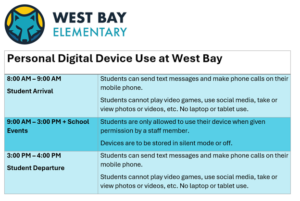Navigating Technology and AI in Education: Where We Are
September 19, 2024 - 4 minutes readOver the past year, two significant conversations have gained heightened attention regarding children and technology.
On one side, concerns about screen time and digital dependency are on the rise. Influential works like Jonathan Haidt’s The Anxious Generation as well as the BC Ministerial Order restricting personal digital devices in schools signal growing unease about children’s attachment to devices and social media.
On the other hand, the rapid advancements and potential of Generative AI are reshaping how we think about technology in education. These digital tools have sparked renewed interest in how they can be harnessed to support personalized learning. Digital devices open windows to new perspectives and offer fertile ground for critical thinking and deep inquiry.
Alongside parents, we at West Bay feel we have a role to help guide students’ relationships with technology. Our goal is to position digital devices as valuable learning tools—tools that are picked up when useful and set aside when not. We aim to balance the benefits of technology with the importance of knowing when it’s time to disconnect.
As partners in shaping our students’ relationship with technology, we see this balance as key. West Vancouver Schools Superintendent Chris Kennedy emphasized this, stating, “We didn’t jump into AI because it was trendy. Our goal isn’t AI itself; it’s the creation of powerful learning experiences.”
Students must learn about Generative AI because it’s increasingly part of their world. Understanding how AI works, when it’s helpful, and when it’s not, is crucial. There will always be tension between AI’s efficiency and the need to nurture curiosity and celebrate authenticity. But AI also holds immense potential to further inclusive lesson planning and offer personalized learning experiences for students.
Where Does West Bay Stand Today?
Many of our teachers are starting to use Magic School—Generative AI provided by West Vancouver Schools—to see where it can enhance their teaching. This includes modifying reading materials to suit different learning levels, creating exemplars and non-exemplars, developing varied assignments to reflect student understanding, and crafting decodable texts to focus on foundational literacy skills. Teachers can also use AI to predict and address student misconceptions, particularly in our Themes of Inquiry.
While students are gradually introduced to what Generative AI is, they’re learning how it works and how it can assist in their studies. Though students are not actively using AI tools yet, many will start, as developmentally appropriate, utilizing them this year. Tasks such as translating, summarizing, leveling texts, comparing writing samples, and seeking alternative perspectives will be supported by AI, further enriching their learning.
A Purposeful Approach
While we are excited for the benefits of our well-established tools like the Google Suite of Education and exploring the benefits of Generative AI for teachers and students, we are reaffirming our expectations regarding the purposeful use of technology. Our expectations are in the table below.
In six months, this post may feel very dated as I am sharing our starting point with Generative AI as new tools and ways to support learning continuously emerge. The landscape is changing quickly, and this is an exciting time to be a learner and educator.
Scott Slater

Recent Comments